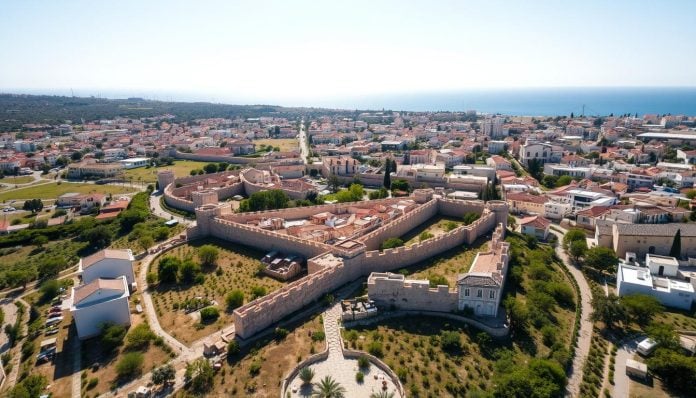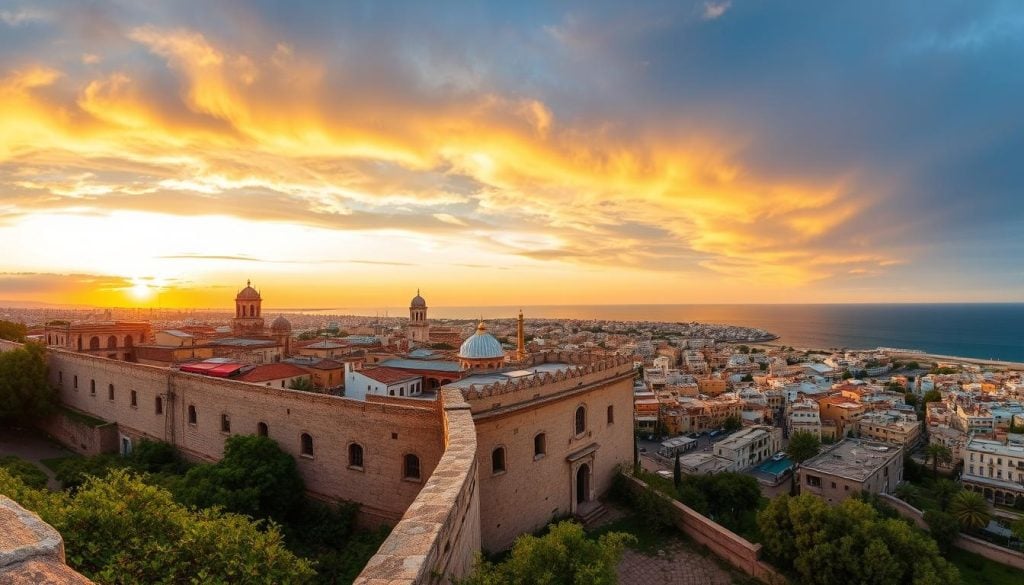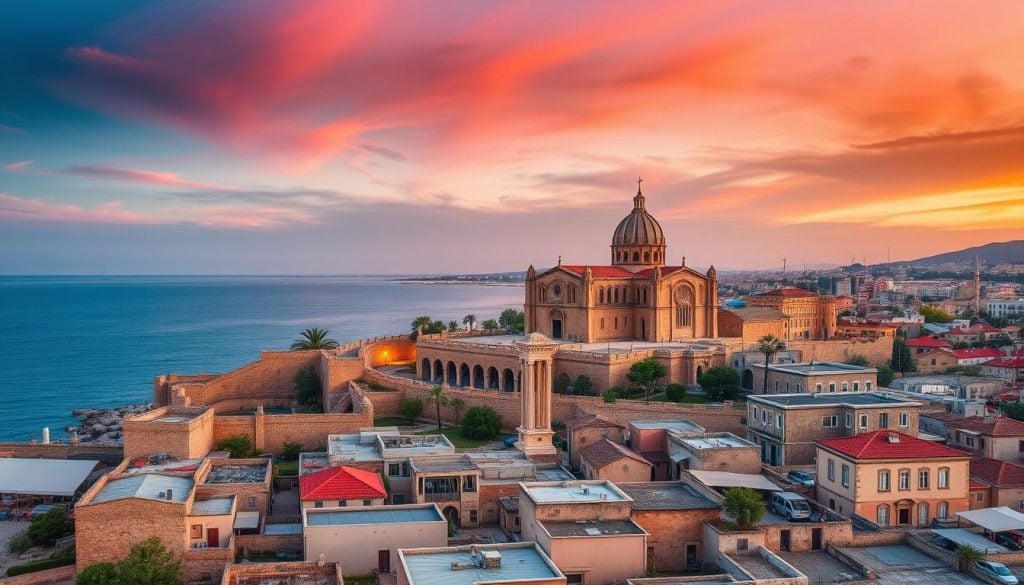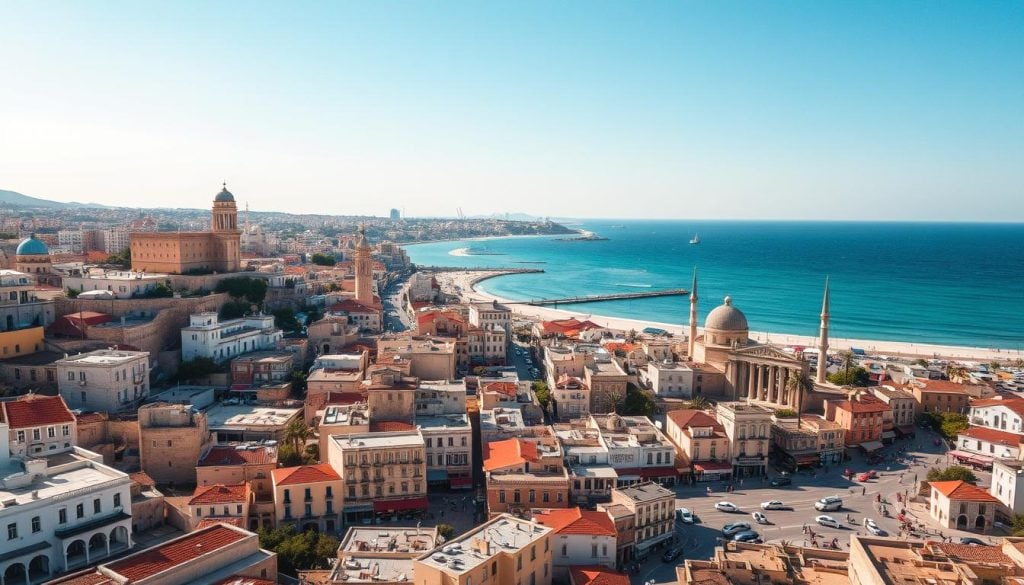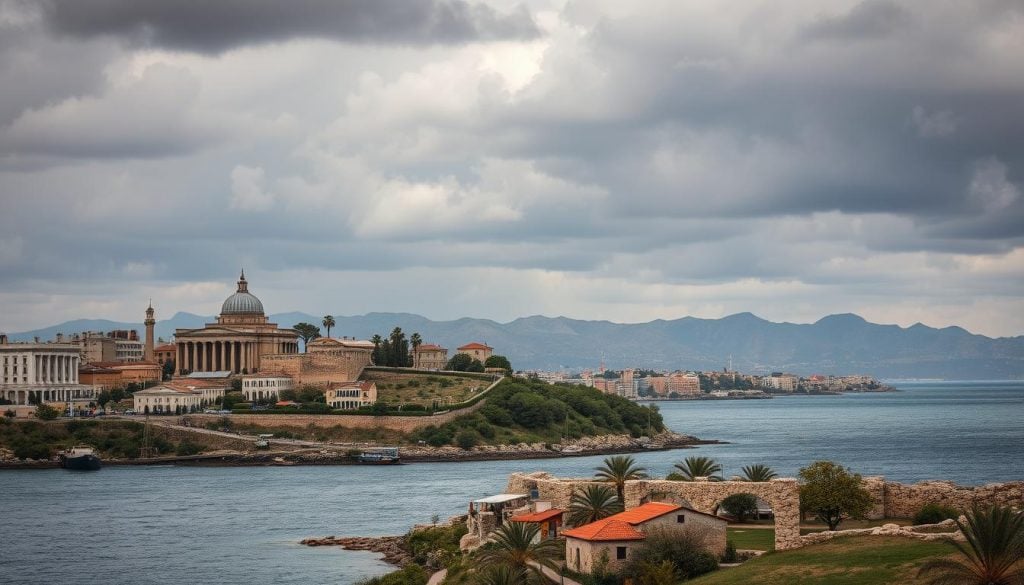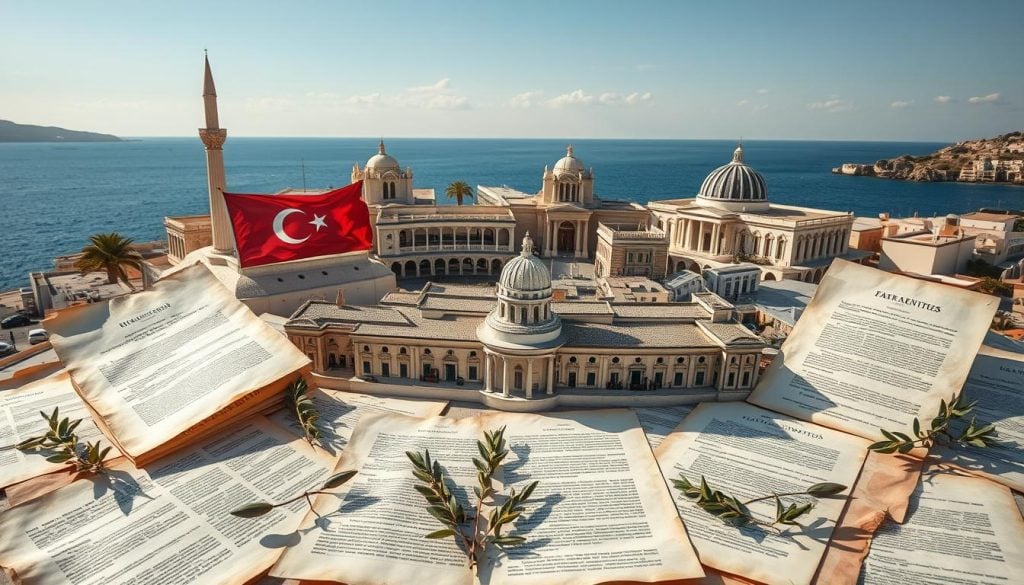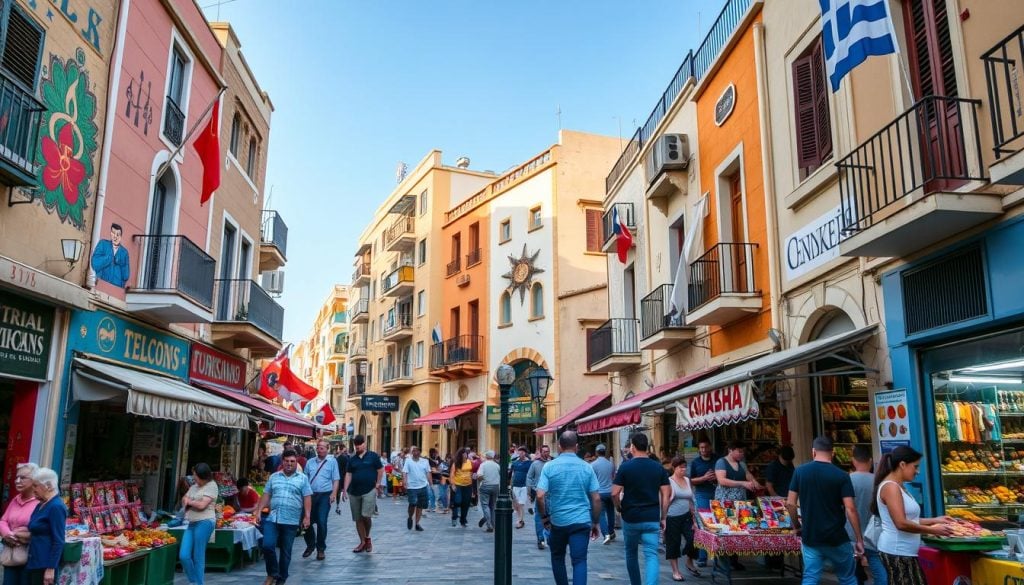Imagine a city caught between two nations, each fighting for its right to claim it. The control of Famagusta is more than just politics. It shows the deep-seated issues in the Cyprus territorial dispute. Does Famagusta belong to Turkey or Greece?
This question takes us back in time, exploring the city’s history. It also looks at the complex issues of sovereignty that affect it today. As you read on, you’ll learn why Famagusta matters, its strategic importance, and the long-standing conflict that surrounds it.
Introduction to Famagusta
Famagusta, also known as Ammochostos in Greek and Gazimağusa in Turkish, is a city with a deep history. It sits on Cyprus’s east coast. The city’s history stretches back to 274 BC, making it a key trading center in the medieval times.
Its name reflects the mix of cultures and empires that shaped it. This blend is a testament to its rich past.
The city’s architecture and archaeological sites are a big draw for visitors. They want to see the city’s ancient history. Its location made it a crucial port, boosting its importance.
Exploring Famagusta, you’ll see how each era has influenced its culture. It’s a city with a unique identity shaped by history.
Historical Overview of Famagusta
Famagusta’s history is like a rich tapestry, filled with many influences over the years. It started as a small fishing town. Then, it grew into a key economic center under the Byzantine Empire.
During the Lusignan rule in the 12th century, Famagusta became a hub of commerce and culture. This was a turning point for the city.
The Venetian period brought big changes, like impressive fortifications and Gothic architecture. These still attract visitors today. The 15th century saw even more fortifications, making Famagusta even more important in the Mediterranean.
In 1571, the Ottomans took over Famagusta. This changed the city’s culture and government. It had a big impact on the city’s future.
From 1878 to 1960, the British ruled Famagusta. This changed the city’s people a lot. The city became mostly Greek Cypriot, changing its identity. Knowing this history helps us understand Famagusta today.
The Significance of Famagusta in Cyprus
Famagusta is key to Cyprus’s culture and economy. It was once a busy port city with a deep harbor. This helped with international trade and tourism, making it very important.
The city’s architecture shows its cultural significance. The Gothic Cathedral of St. Nicholas, now a mosque, tells the city’s story. Famagusta is also known as the “City of 365 Churches,” showing its rich history and cultural mix.
Before 1974, Famagusta was a major tourist spot. It had beautiful beaches and historical sites, drawing visitors worldwide. This made it a big part of Cyprus’s economy. Now, it’s a symbol of the island’s complex history and ongoing disputes.
Is Famagusta under Turkish or Greek control?
Famagusta’s status is complex, tied to its governance and history. The city is a key point of tension between Turks and Greeks. This tension affects the lives of locals, especially Greek Cypriots in Famagusta.
Current Control and Governance
The Turkish Republic of Northern Cyprus (TRNC) controls Famagusta. This control came after Turkey invaded Cyprus in 1974. The invasion led to many Greek Cypriots leaving, changing the city’s leadership.
Today, the city’s leaders do not include Greek Cypriots. They mostly live in exile, like in Limassol.
Impact of the 1974 Turkish Invasion
The Turkish invasion of 1974 changed Famagusta a lot. About 40,000 Greek Cypriots had to leave, changing the area’s people. Many places, like Varosha, are now empty.
This division keeps tensions high. It makes solving problems hard, leading to ongoing issues.
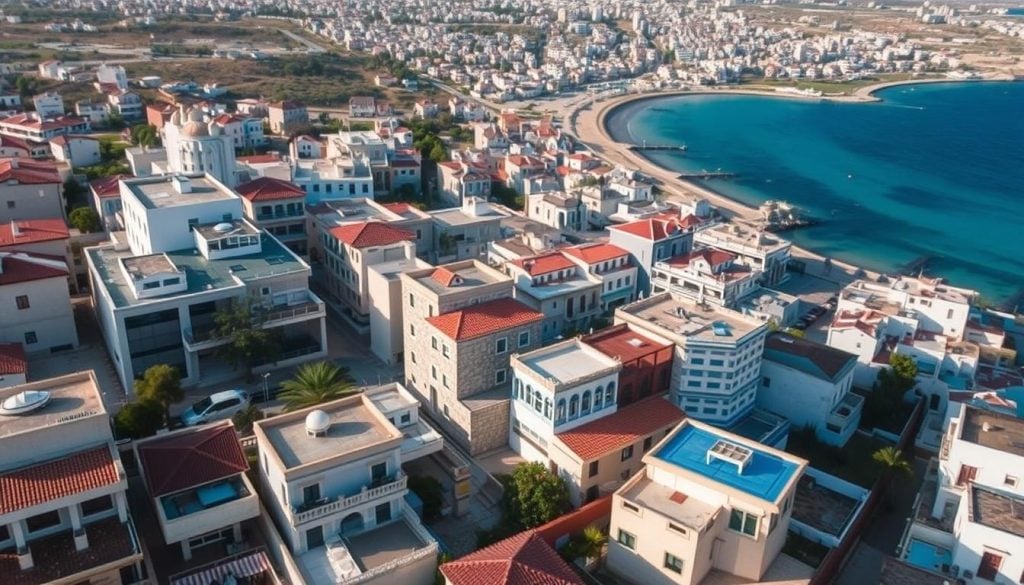
The Famagusta Conflict and Its Roots
The Famagusta conflict is a deep struggle tied to the history of Famagusta. It started from nationalistic tensions between Greek and Turkish Cypriots in the mid-20th century. Historical grievances and political upheavals created a complex web of disputes.
Looking back, the roots of the Cyprus dispute are clear. Decades of events shaped this conflict. Coups and retaliations widened the gap between communities. The 1974 invasion changed everything, leaving questions about sovereignty and territory.
Understanding the Famagusta conflict shows its lasting impact. It’s clear that these events still shape the region’s politics. The need for dialogue and reconciliation is urgent, aiming to unite Greek and Turkish Cypriots.
The Cyprus Territorial Dispute Explained
The Cyprus territorial dispute is a big issue between Greek and Turkish Cypriots. It’s about land and identity, causing long-standing tensions. The history of the island has played a big role in this conflict.
After Cyprus gained independence from Britain in 1960, peace didn’t last. Violence between groups started, leading to the island’s split in 1974. Today, Cyprus has two main areas: the Republic of Cyprus, recognized worldwide, and the Turkish Republic of Northern Cyprus (TRNC). The TRNC is only recognized by Turkey.
Understanding the Cyprus conflict is key to seeing the ongoing issues. It’s about fixing past problems and dealing with today’s politics. This dispute affects not just the island’s people but also global efforts for peace.
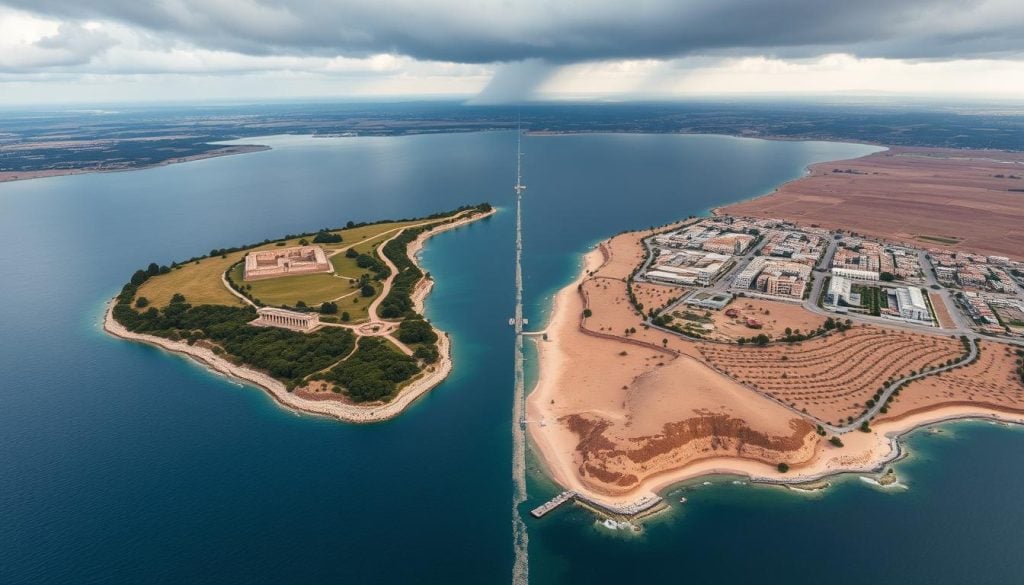
Impact of International Laws and Resolutions
The situation in Famagusta is closely tied to international laws and resolutions. The United Nations plays a key role in trying to solve the Cyprus conflict. The international community watches the city closely, showing the importance of legal frameworks and talks.
United Nations Involvement
UN resolutions on Cyprus stress the need for peace and the return of displaced people. Resolutions 550 and 789 demand Varosha’s return to its rightful owners, under UN control. Turkey’s actions, however, have raised questions about its compliance, making a solution harder to find.
These laws on Famagusta guide talks aimed at a lasting peace.
European Union’s Stance on Famagusta
The EU is committed to upholding international law and supporting the UN. EU officials push Turkey to follow resolutions and respect the island’s legal status. The EU’s involvement shows its concern for human rights and its wish for peace between communities.
Economic and Cultural Impact of Division
The division of Famagusta has caused big economic problems. It was once a bustling center for tourism and trade. Now, it’s a ghost town, affecting both local and national economies.
The delay in reopening Varosha has hurt tourism and Famagusta’s chances to recover. This area was once full of life and visitors. Now, it’s empty and forgotten.
Tourism was key to Famagusta’s success. Its beautiful beaches and history drew many visitors. But now, it’s all gone, leaving behind a city with lost opportunities.
The decline has hurt more than just numbers. It has changed communities and damaged cultural heritage. The city’s identity is fading with the loss of tourism and history.
Famagusta’s division is a sad reminder of lost heritage. Varosha’s isolation has hurt both residents and the city’s cultural ties. The world waits to see if these can be rebuilt.
| Impact Area | Before Division | After Division |
|---|---|---|
| Tourism Revenue | High, with a vibrant tourism industry | Significantly low, many businesses closed |
| Local Economy | Thriving; supported by diverse sectors | Declined; reliance on external aid |
| Community Cohesion | Strong connections among residents | Fragmented; loss of shared experiences |
| Cultural Heritage | Celebrated and preserved | Threatened; loss of historical landmarks |
Conclusion
The control of Famagusta is a complex issue tied to the Cyprus territorial dispute. To understand if Famagusta is under Turkish or Greek control, we must look at its history. This history is filled with cultural identities and political tensions.
The future of Famagusta depends on the Turkish and Greek Cypriot communities’ hopes. It also relies on international actions that affect local rule. The ongoing talks for peace show that solving Famagusta’s status is key to resolving the Cyprus issue. It’s a symbol of the fight for identity and unity in a divided area.
Famagusta is a small example of the big push for peace and unity in Cyprus. Talks about its future show the deep desire for both sides to live together in harmony. If they succeed, it will not only make governance easier in Famagusta. It will also help bring lasting peace to the whole island.

































